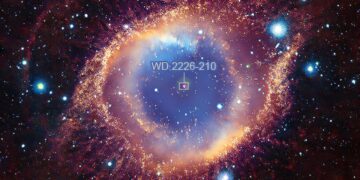The universe is full of celestial wonders, but some mysteries linger for decades before they are unraveled. One such mystery has finally been explained—the puzzling X-ray emissions from the Helix Nebula’s central white dwarf, WD 2226-210. For over 40 years, astronomers have been detecting unexpected high-energy X-rays from this dying star, but the source of this radiation remained unknown. Recent research now suggests that this X-ray signal may be the aftermath of a planet being ripped apart by the star’s intense gravity.
What is the Helix Nebula?
The Helix Nebula is one of the most famous planetary nebulas in the night sky. Located 650 light-years away in the constellation Aquarius, it is often called the “Eye of God” due to its striking resemblance to a giant cosmic eye.
A Dying Star’s Beautiful Remnants
A planetary nebula forms when a Sun-like star exhausts its nuclear fuel and sheds its outer layers into space, leaving behind a dense, Earth-sized remnant called a white dwarf. The expelled gas forms a glowing shell around the white dwarf, creating the colorful and eerie appearance of a planetary nebula.
The Central Star: WD 2226-210
At the heart of the Helix Nebula lies WD 2226-210, a white dwarf—the remnant of a once-massive star. These stellar corpses gradually cool over billions of years, no longer sustaining nuclear fusion but still radiating residual heat and energy. However, WD 2226-210 was emitting X-rays far stronger than expected, raising questions about its source.
The Mysterious X-Ray Signal: A 40-Year Puzzle
Decades of Unexplained Radiation
Since the 1980s, multiple space telescopes—including NASA’s Einstein Observatory, ROSAT, Chandra X-ray Observatory, and ESA’s XMM-Newton—have detected an anomalous X-ray emission from WD 2226-210. Typically, white dwarfs emit low-energy X-rays, but the Helix Nebula’s white dwarf was producing high-energy X-rays, which require extreme heat and activity.
A Breakthrough in 2025
Using the latest observations from Chandra and XMM-Newton, researchers finally solved this decades-old enigma—the X-rays likely come from planetary debris falling onto the white dwarf’s surface. This suggests that the white dwarf recently tore apart a planet, causing its remains to spiral inward and heat up, releasing powerful X-ray radiation.
The Evidence: A Planet Pulled Apart by a White Dwarf
A Neptune-Sized Planet in a Tight Orbit
Astronomers had already discovered a Neptune-sized planet orbiting WD 2226-210, completing an orbit in just three days. This meant that the system likely still retained some planetary remnants, even after the star transitioned into a white dwarf.
The Role of Gravitational Interactions
Scientists theorize that a Jupiter-sized planet may have migrated inward over time due to gravitational interactions with other planets in the system. As it moved dangerously close to the white dwarf, tidal forces would have torn it apart, breaking it into pieces that eventually spiraled into the star.
X-Ray Signature of Planetary Accretion
As the fragments of the destroyed planet crashed onto the white dwarf’s surface, they would have been superheated to millions of degrees, producing the intense X-ray emissions detected by telescopes. This process is similar to what happens in accreting black holes, where matter falling into a massive object releases high-energy radiation.
What This Discovery Means for Planetary Evolution
A New Fate for Exoplanets
Until now, scientists primarily studied exoplanets that orbit stable stars. However, this discovery shows that planets can still interact with white dwarfs long after their host stars have died. This has major implications for understanding:
- How planetary systems evolve after a star becomes a white dwarf
- Whether planets can survive or if they inevitably fall into their dying stars
- How common these planet-destroying events are across the galaxy
What This Means for the Solar System
Our own Sun will become a white dwarf in about 5 billion years, leaving behind its planetary system. While Earth will likely be engulfed when the Sun expands into a red giant, Jupiter, Saturn, and other outer planets may survive. However, if a process similar to the one observed in the Helix Nebula occurs, they could eventually be pulled into the dying Sun’s remnant, suffering the same fate as the planet in this study.
A New Class of X-Ray Sources?
Similar White Dwarf Systems Show the Same Pattern
Interestingly, WD 2226-210 is not alone. Two other white dwarfs outside planetary nebulas have shown similar X-ray activity, leading scientists to speculate that this may be a more common phenomenon than previously thought.
Expanding Our Search for Destroyed Planets
If this process happens frequently, astronomers may need to rethink how planetary systems die. White dwarfs were once thought to be quiet, slowly cooling stellar remnants, but this study suggests that some white dwarfs continue to consume planetary material long after their formation.
Future Research: What Comes Next?
Confirming the Theory
Although the evidence strongly supports the idea that a planet was destroyed by WD 2226-210, astronomers will need to conduct more observations to confirm this hypothesis. They will look for:
- Additional X-ray variations that indicate active accretion
- Infrared signatures of leftover planetary debris
- Other white dwarfs exhibiting the same pattern
Hunting for More White Dwarfs Eating Planets
Astronomers will now focus on identifying other white dwarf systems that might show similar X-ray behaviors. This could help determine how often planets fall into white dwarfs and whether planetary destruction is a common phase of stellar evolution.
Conclusion: A Groundbreaking Discovery in the Life and Death of Planets
For decades, the Helix Nebula’s mysterious X-ray signal left scientists searching for answers. Now, the evidence suggests that we may be witnessing the final moments of a planet’s existence—a catastrophic destruction by its dying star.
Reference:
S Estrada-Dorado et al, Accretion onto WD 2226-210, the central star of the Helix Nebula, Monthly Notices of the Royal Astronomical Society (2024). DOI: 10.1093/mnras/stae2733



















